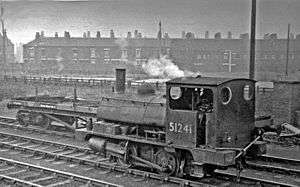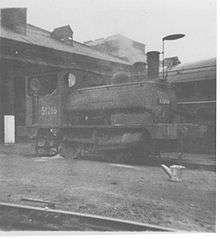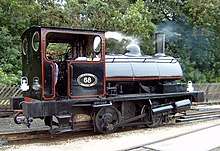L&YR Class 21
The L&YR Class 21 is a class of small 0-4-0ST steam locomotive built by the Lancashire and Yorkshire Railway for shunting duties. They were nicknamed Pugs.
| L&YR Class 21 | |||||||||||||||||||||||||||
|---|---|---|---|---|---|---|---|---|---|---|---|---|---|---|---|---|---|---|---|---|---|---|---|---|---|---|---|
 L&YR 'Pug' 0-4-0ST at work in Goole Docks 1954 | |||||||||||||||||||||||||||
| |||||||||||||||||||||||||||
| |||||||||||||||||||||||||||
| |||||||||||||||||||||||||||
| |||||||||||||||||||||||||||
Construction history
The class originates in the purchase of three saddle tank locomotives ordered from Vulcan Foundry in 1886. They were fitted with an 8-foot-10-inch (2.69 m) long, 3-foot-0-inch (914 mm) diameter boiler pressed to 140 lbf/in2 (965 kPa) powering two outside 13-by-18-inch (330 mm × 457 mm) cylinders connected to 3-foot-0-inch (914 mm) driving wheels. The wheelbase was 6 ft 0 in (1.83 m) and the total heating surface of the saturated boiler was 475.75 sq ft (44.20 m2).[1]
J. A. F. Aspinall then ordered more locomotives of a modified design: the wheelbase was shortened to 5 ft 9 in (1.75 m), the tank was extended over the smokebox, the cab was enlarged, [2] and the boiler pressure raised to 160 lbf/in2 (1,103 kPa). Seventeen of this modified design were ordered from Horwich Works in three batches; Aspinall's successor Henry Hoy order another batch of 10; and Hoy's successor George Hughes ordered 30 more in two batches.
| Lot No. | Qty | Manufacturer | Serial Nos. | Year | L&Y Nos. | LMS Nos. |
|---|---|---|---|---|---|---|
| — | 3 | Vulcan Foundry | 1176–1178 | 1886 | 916–918 | 11200, —, — |
| 10 | 6 | Horwich Works | (none) | 1891 | 1153–1156, 32, 310 | 11201–11206 |
| 20 | 6 | Horwich Works | (none) | 1893–94 | 504, 654, 729, 1230–1232 | 11207–11212 |
| 26 | 5 | Horwich Works | (none) | 1895 | 1286–1290 | 11213–11217 |
| 46 | 10 | Horwich Works | 811–820 | 1901 | 68, 113, 139, 155, 377, 389, 399, 402, 403, 476 | 11218–11227 |
| 52 | 10 | Horwich Works | 921–930 | 1905–06 | 260, 813, 814, 821, 823, 825, 832, 840, 865, 879 | 11228–11237 |
| 65 | 20 | Horwich Works | 1092–1111 | 1910 | 2, 3, 8, 12, 17, 19, 28, 43, 56, 64, 71, 75, 118, 226, 271, 298, 481, 517, 613, 614 | 11238–11257 |
The last locomotive was delivered in July 1910, four months before the first retirement; 917 and 918 were withdrawn in November that year, but were not scrapped until November 1912.[2]
Operational history

The London, Midland and Scottish Railway (LMS) gave the locomotives the power classification 0F. In total sixty were made between 1886 and 1910. They were built for use in sharply curved sidings for shunting duties. The Pugs were allocated by the L&YR for operation in the industrial areas and docks of Fleetwood, Goole, Liverpool and Salford. In later times they became more widely dispersed, reaching places such as Bristol, Bangor, Crewe, Derby, Widnes, York and Swansea. When the LMS was merged into British Railways on 1 January 1948, 23 'Pugs' remained in service; BR added 40,000 to their fleet numbers.
Withdrawal
Withdrawals started in 1910 with two going in that year. Four went in the 1920s, 31 in the 1930s; leaving 23 to be withdrawn between 1957 and 1964.
| Year | Quantity in service at start of year | Quantity withdrawn | Locomotive numbers | Notes |
|---|---|---|---|---|
| 1910 | 60 | 2 | 917–918 | |
| 1924 | 58 | 1 | 11220 | to service stock, scrapped 1930 |
| 1925 | 57 | 1 | 916 | LMS number not applied |
| 1926 | 56 | 2 | 1153, 654 | LMS numbers not applied |
| 1930 | 54 | 4 | 11210/14/19/42 | |
| 1931 | 50 | 10 | 11203/09/26/33/38/43/47–48/52 | 11238 in service stock since 1924; 11243 sold to Mowlem & Co. Bassett, then to United Glass Bottle Manufacturers Prince, then to preservation |
| 1932 | 40 | 4 | 11211/25/28/30 | 11225 sold to J. F. Wake |
| 1933 | 36 | 3 | 11223/45/51 | 11245 in service stock since 1931, sold to North Wales Granite Co.; 11251 sold to Frazer & Co. |
| 1934 | 33 | 5 | 11213/24/36/55–56 | 11224 sold to A. R. Adams; 11255 sold to J. F. Wake |
| 1935 | 28 | 2 | 11205/39 | |
| 1936 | 26 | 1 | 11249 | sold to Cooke & Nuttall |
| 1937 | 25 | 1 | 11257 | sold to Holloway Brothers |
| 1938 | 24 | 1 | 11215 | |
| 1956 | 23 | 1 | 51216 | |
| 1957 | 22 | 3 | 51212/34/40 | 11234 in service stock between 1924 and 1933 |
| 1958 | 19 | 3 | 51202/30/35 | |
| 1959 | 16 | 1 | 51231 | |
| 1960 | 15 | 2 | 51221/27 | |
| 1961 | 13 | 3 | 51217/29/46 | |
| 1962 | 10 | 6 | 51204/06–07/22/41/44 | |
| 1963 | 4 | 3 | 51232/37/53 | 11253 stored between 1924 and 1928 |
| 1964 | 1 | 1 | 51218 | Preserved |
Accidents and incidents
- On 5 July 1963, one of the driving wheels of locomotive No. 51232 sheared off at Salford, Lancashire.[4]
Preservation

Two "Pugs" have survived into preservation, both through the Lancashire and Yorkshire Railway Trust.[5] L&YR No. 19 (LMS No. 11243), built in 1910, was sold by the LMS into industry in 1931 and was acquired by the Trust from the United Glass Bottle Manufacturers Ltd. at Charlton in 1967. It was found to be in poor mechanical condition and was later placed on static display pending overhaul, most recently at the Ribble Steam Railway, although since early 2020 it has been at the East Lancashire Railway at Bury.
L&YR No. 68 (LMS No. 11218, BR No. 51218), built in 1901, was purchased directly from British Rail in 1964 and moved to the Keighley and Worth Valley Railway in January 1965. The locomotive was re-tubed in 1974 and took part in the Stockton & Darlington Railway cavalcade that year. The locomotive was overhauled again in 1997 and continued in service, albeit mostly as a shunting locomotive due to its low power, until its boiler tubes required replacement in 2006. The locomotive carried its original identity of L&YR 68 from 2004 onwards, but has been cosmetically restored in 2018 to 51218 for the K&WVR's 50th Anniversary Gala, reflecting that 51218 was the first loco to arrive in 1965. Overhaul is now under consideration at Haworth on the K&WVR as the restoration of 0-6-0ST No. 752 has now been completed at the East Lancashire Railway.[6]
Models
Several models of the 'Pug' have been produced commercially.
The first was a 'OO'-scale polystyrene kit made in the 1960s by Kitmaster, the moulds for which were subsequently sold to Airfix then passed on to Dapol, which still manufactures the former Airfix plastic kit range. This kit has often been used as the basis for a narrow-gauge 'pug bash' locomotive running on 00-9 tracks.
A ready-to-run OO model was produced initially by Dapol and then Hornby where the Pug was produced until 2000. The Pug was reintroduced to Hornby's range in 2010 (R2927) in early British Railways Livery.
Larger scale models are available from a number of suppliers including Tower Models of Blackpool.
See also
References
- Baxter, Bertram (1982). Baxter, David (ed.). British Locomotive Catalogue 1825–1923, Volume 3B: Lancashire and Yorkshire Railway and its constituent companies. Ashbourne, Derbyshire: Moorland Publishing Company. pp. 69–70, 88–89. ISBN 0-903485-85-0.
- Casserley, H. C. & Johnston, Stuart W. (1974) [1966]. Locomotives at the Grouping 3: London, Midland and Scottish Railway. Shepperton, Surrey: Ian Allan. pp. 111–112. ISBN 0-7110-0554-0.
- Earnshaw, Alan (1993). Trains in Trouble: Vol. 8. Penryn: Atlantic Books. ISBN 0-906899-52-4.CS1 maint: ref=harv (link)
- Baxter 1982, p. 69.
- Baxter 1982, p. 70.
- Baxter 1982, pp. 69–70, 88–89.
- Earnshaw 1993, p. 37.
- http://www.lyrtrust.org.uk
- http://www.lyrtrust.org.uk/
External links
| Wikimedia Commons has media related to L&YR Class 21. |